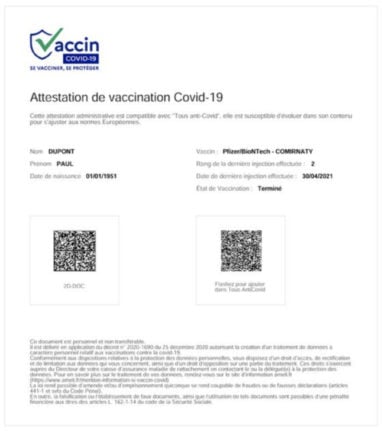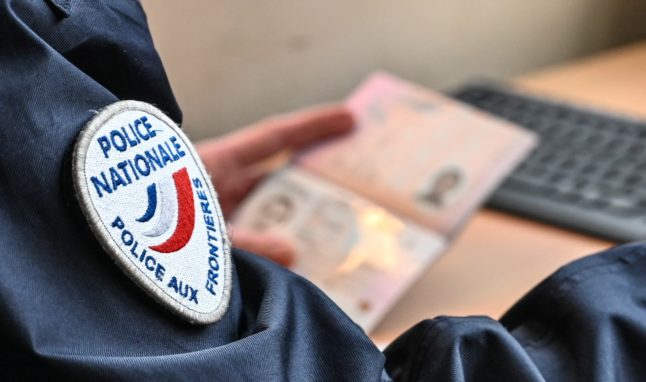Here’s how it should work:
After getting your vaccination in France you should get a certificate with a QR code on it that looks like this:

You download the TousAntiCovid app (if you have not already, it’s the same app that is used for Covid tracking and where you can find the attestation form for trips out after curfew), head to the ‘My wallet’ section and scan the code on the right hand side of your certificate.
Once you are fully vaccinated (two weeks after receiving two doses of Pfizer, Moderna or AstraZeneca or one dose of Johnson & Johnson or one dose if you have recently had Covid) the app should then produce for you a code with your name, date of birth, the type of vaccine you had and – crucially – the vaccine status terminé (finished) indicating that you are fully vaccinated.
You can use this app to gain access to venues such as concerts, museums, cafés and trains over the summer.
You can also use it to travel within the EU or Schegen zone via the EU digital vaccine passport – here’s how to make sure your certificate is compatible with the EU system.
READ ALSO How France’s health passports will work this summer
If you have not yet been vaccinated you can you present evidence of a recent negative Covid test or recent recovery from Covid.
If you do not have a smartphone you can show a paper copy with a QR code of your vaccination certificate or recent negative test.
So that’s the theory, but there are some problems and anomalies within the system.
Here are the most common problems and how to solve them:
People vaccinated before May 3rd either didn’t get a certificate or got one without a QR code, meaning that it cannot be scanned into the app. For most people, certificates with the necessary code are now available via the online Ameli portal.
#Covid19 | Depuis son lancement, le téléservice https://t.co/zFUnLUVTo1 a déjà permis le téléchargement de 1,3 million d'attestations de #vaccination certifiées 📄
En savoir ➕ https://t.co/j7Hvev9UXo pic.twitter.com/VoyQYY2ZrD
— Assurance Maladie (@ameli_actu) June 1, 2021
The Assurance maladie health system says that since May 27th, 1.3 million certificates have been provided to patients who had received their vaccine earlier. You can access it by heading to your Ameli account and either searching attestation de vaccination Covid-19 or clicking on this link.
If you don’t have an Ameli account you can set one up, provided you are registered in the French health system – details on how to set up the account here.
If you are not registered in the French health system and therefore do not have a carte vitale you are still entitled to be vaccinated and if you had your vaccine after May 3rd you should have been given a paper certificate with the correct QR code that can be scanned directly into the app. However if you were vaccinated before May 3rd you will not be able to use the Ameli route to get your certificate.
The Local asked the health ministry for its advice in this circumstance and we were told that people should go back to the doctor, pharmacy or vaccine centre where they got the vaccine, taking with them ID and the paperwork they were given at the time, and swap it for the new certificate.
If you only had one dose of the vaccine, your certificate might incorrectly show up as en cours (in progress) rather than terminé (finished) and this is important because only people with the terminé status are considered ‘fully vaccinated’ in terms of the health passport.
France’s policy is that people who have had Covid in recent months only need a single dose of the double-dose vaccines (Pfizer, Moderna and AstraZeneca), in consultation with a health professional, and that this should be marked on health records as a second dose, giving people the vaccine status terminé.
However reports in the French media suggest that some people who only received a single dose have not been marked as fully vaccinated, in what appears to be human error in inputting the details.
In this case, the health ministry tells people to approach a medical professional who has access to the database (a GP or pharmacist) taking with them ID, vaccine certificates and test results to show proof of recovery from Covid so their records can be altered. In this case it does not have to be at the place where you received the vaccine.
If you have an Ameli account up and running but it is showing no documents relating to vaccination, the advice is to return to the centre where you had your vaccine with ID and your old certificate to swap it for a new one with the correct code.
If you had your vaccines outside France things are a little more complicated.
Vaccinations done within the EU are compatible with the French system, thanks to the EU vaccine passport scheme.
READ ALSO How the EU’s health passports will work this summer
Those vaccinated in non-EU countries cannot, for the moment use the French health passport, although talks are ongoing on this issue.
They can, however, present a paper or digital vaccination certificate – or the NHS app for people vaccinated in the UK – for proof of vaccinated status. However, this is only accepted if the vaccine has been approved for use within the EU – Pfizer, Moderna, AstraZeneca (but not Covishield) and Johnson & Johnson.
We will update our Travelling to France section with the latest on travel rules.



 Please whitelist us to continue reading.
Please whitelist us to continue reading.
I had my second dose today in a centre many miles from my home and only after I had left realised the vaccine certification with the QR code was only showing one vaccination with the status being en cours. I returned immediately to the vaccination centre to get the mistake corrected but was told there was nothing that could be done and I would have to correct it on the Ameli website, I explained that as I did not have a carte vitale, I could not access this site be but still the reply was « I can do nothing » After reading your article I went to my local vaccination centre and asked them to correct the database but again I was told « no we cannot fix this » and they said I would have to return to the centre that provided the vaccination. I then went to my local pharmacy and asked could they access the database to make the correction and the difference that a person with the willingness to help made was amazing, a very kind young man was willing to explore the possibilities and eventually with some difficulty was able to correct the mistake and I received an updated certificate.
So you got it sorted why make such an issue of it. Perhaps you may consider getting a carte vitale now.
My comments were to encourage people who have had difficulties to keep trying to find solutions, not to make an issue of it as you have suggested. As a recent resident of France I have yet to receive my carte vitale, this process takes time and having a correctly documented vaccination is important, especially when you are waiting to see family that one has not seen in too long a time. As soon as the EU covid digital certificate is deployed I hope to see my children again.
I am leaving for France June 30. All I have is my fully vaccinated certificate from a vaccine clinic in Santa Barbara California… No QR code. Still no decision or information about how Americans can get their hands on documents or codes that France or the EU will recognize. Am I missing something? Thanks!
Cynthiaziegler10,
To be safe and free from French bureaucracy, ensure yourself a PCR test within 72 hours of your arrival in France ( don’t forget your vaccination card ). International visitors must meet this second requirement.